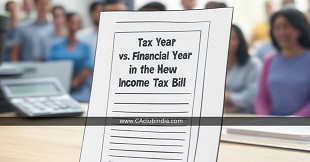CAclubindia Articles
Understanding 'Tax Year' vs. 'Financial Year' in the New Income Tax Bill
Ayush 18 February 2025 at 13:02One of the most notable changes is the introduction of the term "tax year," which replaces the concept of the "previous year" and the "assessment year" from the Income Tax Act, 1961.
A Comparative Study on the Old and New Tax Bill
Poojitha Raam Vinay 18 February 2025 at 10:34On 13th February 2025, Hon'ble Finance Minister Smt Nirmala Sitharaman proposed the New Tax Bill. The new bill is proposed to come into force on April 1, 2026. ..
Missed Intra-Head LTCG Setoff: Impact of Section 112 Amendments vs. Section 48
Prahlad Raykar 18 February 2025 at 08:33Long-Term Capital Gain(LTCG)- Intra head LTCG setoff missed due to amendments in section 112 and not in Sec48.
This Valentine's, Fall in Love with Simpler Tax Laws!
CA Umesh SharmaThe govt has proposed this fresh and straightforward law, one that taxpayers will appreciate-perhaps even fall in love with! Just like a well-crafted Valentine's letter is easy to read and understand, this new Bill aims to win the hearts of taxpayers by bringing clarity, simplicity, and ease to tax compliance.
Comprehensive Comparison of Section Numbers: Income Tax Act, 1961 vs. Income Tax Act, 2025
CA Varun Gupta 18 February 2025 at 08:33To assist with this transition, the government has released a comparison chart that maps the sections of the Income Tax Act 1961 to their corresponding sections in the Income Tax Act 2025. This chart will be highly beneficial in helping you quickly locate the new sections if you remember the old section numbers.
Company and LLP Strike Off vs. Winding Up: Key Differences and Procedures in India
Vivek Ranjan 18 February 2025 at 08:33Businesses in India may shut down due to financial constraints, regulatory challenges, or strategic changes. The two main ways to close a Company or Limited Lia..
Impact of GSTR 2A on Input Tax Credit (ITC) Claims
Ishita RamaniGSTR 2A is a vehicle-generated statement in the GST portal that reflects inward materials based totally on the GSTR 1 filed via providers.
Form GST ENR-03: A Progressive Step Towards Inclusive E-Way Bill Compliance
CA Rohit Sonar 17 February 2025 at 07:34CBIC introduced Form GST ENR-03. Effective from February 11, 2025, this form facilitates the enrollment of unregistered persons on the e-Way Bill portal, enabling them to generate e-Way Bills independently.
New Invoice Management System (IMS) in GST
CA.Sangam AggarwalIMS was developed by GST Council and GSTN (Goods and Services Network) and it was launched on 1st October 2024, made available to users on 14th October for ITC computation and claim process.
Aadhaar Authentication: Latest Indian GST Update
Abhishek Raja 17 February 2025 at 07:34To address concerns of potential revenue leakage, the Government introduced Aadhaar Authentication requirements under the Goods and Services Tax (GST) laws.
Popular Articles
- Revised MSME Criteria: Key Amendments and Threshold Changes for 2025
- CA Final Exams Now Three Times a Year - A Boon or Burden?
- Taxation of Digital Marketing Services: 44AD vs. 44ADA
- Important Things from GST Aspect to Remember this March 2025 ending!
- Finance Bill 2025: Key Tax Reforms for Charitable Trusts and Their Impact
- Important Tasks to do before 31st March 2025
- New Financial Year, New Rules: Tax Changes That Will Make (or Break) Your Wallet
- Double Taxation Avoidance Agreement: Rules & Tax Relief Benefits

Trending Online Classes
-
Certification Course on GSTR-3B Reconciliation with GSTR-2B through Chat GPT
 CA Deepak Gupta26 April 2025
CA Deepak Gupta26 April 2025











 CAclubindia
CAclubindia

